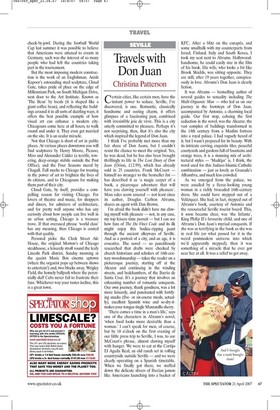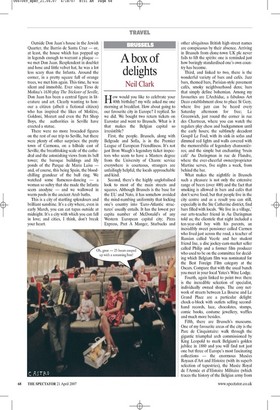SEVILLE
Travels with Don Juan
Christina Patterson
Certain cities, like certain men, have the instant power to seduce. Seville, I’ve discovered, is one. Romantic, classically handsome and oozing charm, it offers glimpses of a fascinating past, combined with irresistible joie de vivre. This is a city utterly committed to pleasure. Perhaps it’s not surprising, then, that it’s also the city which inspired the legend of Don Juan.
I think I’ve probably met more than my fair share of Don Juans, but I couldn’t resist the chance to meet the original. Yes, he was dead, but he has also been brought thrillingly to life in The Lost Diary of Don Juan (Orion, £12.99), which has already sold in 25 countries. Frank McCourt himself no stranger to the bestseller list has described it as ‘a magic carpet of a book, a picaresque adventure that will have you clawing yourself with pleasure’. Mass sales seem assured — not least since its author, Douglas Carlton Abrams, shares an agent with Dan Brown.
I’m afraid the book didn’t have me clawing myself with pleasure — not, in any case, my top leisure-time pursuit — but I can see how fans of The Da Vinci Code and its ilk might enjoy this bodice-ripping jaunt through the ancient alleyways of Seville. And as a portrait of a city, and an age, it is evocative. The novel — so punctiliously researched that drafts were checked by church historians and scholars of 16th-century swordsmanship — takes the reader on a picturesque journey, starting off at the Alcazar and continuing in the winding streets, and bedchambers, of the Barrio de Santa Cruz. It’s a journey that involves an exhausting number of romantic conquests. Our own journey, thank goodness, was a lot more leisurely, and punctuated with fortifying snacks (fiveor six-course meals, actually), excellent Spanish wine and so-dry-itmakes-your-tongue-tingle Manzanilla sherry.
‘There comes a time in a man’s life,’ says one of the characters in Abrams’s novel, ‘when food looks more desirable than a woman.’ I can’t speak for men, of course, but by 10 o’clock on the first evening of our little press trip to Seville, I was, to use McCourt’s phrase, almost clawing myself with hunger. We were to eat at the Cortijo El Aguila Real, an old ranch set in rolling countryside outside Seville — and we were clearly operating on a Spanish timetable. When we finally got there, we stuffed down the delicate slivers of Iberian jamon like Americans launching into a bucket of KFC. After a blitz on the canapés, and some smalltalk with my counterparts from Israel, Finland, Italy and South Korea, I took my seat next to Abrams. Hollywoodhandsome, he could easily star in the film of his book. His wife, who looks a bit like Brook Shields, was sitting opposite. They are still, after 19 years together, conspicuously in love. Abrams’s Don Juan is clearly fiction.
It was Abrams — bestselling author of several guides to sexuality including The Multi-Orgasmic Man — who led us on our journey in the footsteps of Don Juan, accompanied by Antonio, a charming local guide. Our first stop, echoing the first seduction in the novel, was the Alcazar, the vast complex of buildings transformed in the 14th century from a Muslim fortress into a royal palace. I had vaguely heard of it, but I wasn’t prepared for its beauty. With its intricate carving, exquisite tiles, peaceful courtyards and gardens full of fountains and orange trees, it is a stunning mix of architectural styles — ‘Mudéjar’ is, I think, the word used for this Judaeo-Islamic-Catholic combination — just as lovely as Granada’s Alhambra, and much less crowded.
As we emerged from the palace, we were assailed by a fierce-looking young woman in a richly brocaded 16th-century dress. She could have stepped out of a Velázquez. She had, in fact, stepped out of Abrams’s book, courtesy of Antonio and the resourceful Seville tourist board. This, it soon became clear, was ‘the Infanta’, King Philip II’s favourite child, and one of Abrams’s Don Juan’s myriad conquests. If she was as terrifying in the book as she was in real life (or what passed for it in the weird postmodern universe into which we’d apparently stepped), then it was something of a miracle that he ever got near her at all. It was a relief to get away. Outside Don Juan’s house in the Jewish Quarter, the Barrio de Santa Cruz — or, at least, the house which has popped up in legends enough to warrant a plaque we met Don Juan. Resplendent in doublet and hose and little velvet hat, he was a lot less scary than the Infanta. Around the corner, in a pretty square full of orange trees, we met him again. This time, he was silent and immobile. Ever since Tirso de Molina’s 1630 play The Trickster of Seville, Don Juan has been a central figure in literature and art. Clearly wanting to honour a citizen (albeit a fictional citizen) who has inspired the likes of Molière, Goldoni, Mozart and even the Pet Shop Boys, the authorities in Seville have erected a statue.
There were no more brocaded figures on the rest of our trip to Seville, but there were plenty of other surprises: the pretty town of Carmona, on a hillside east of Seville; the breathtaking scale of the cathedral and the astonishing views from its bell tower; the baroque buildings and lily ponds of the Parque de Maria Luisa and, of course, this being Spain, the bloodchilling grandeur of the bull ring. We watched some flamenco-dancing — a woman so sultry that she made the Infanta seem anodyne — and we wallowed in warm pools in the ancient Arab baths.
This is a city of startling splendours and brilliant sunshine. It’s a city where, even in early March, you can eat tapas outside at midnight. It’s a city with which you can fall in love; and cities, I think, don’t break your heart.



















































































 Previous page
Previous page